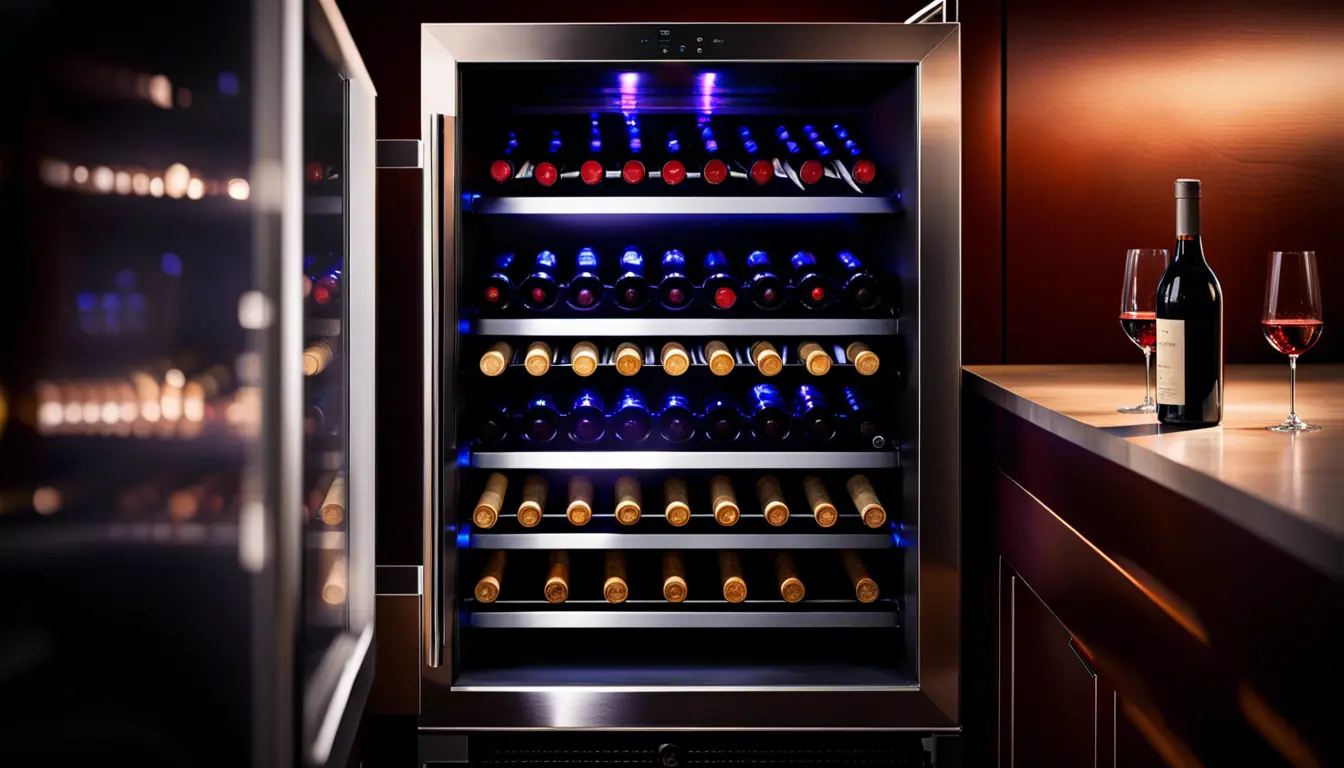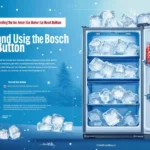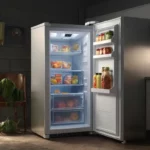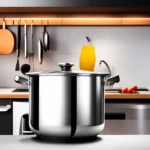A wine cooler is a popular appliance that helps keep your favorite wines at the perfect temperature for serving and enjoyment. However, there may be instances where you notice your wine cooler freezing up unexpectedly.
In this article, we will cover the potential reasons behind this issue and offer some solutions to help you prevent it from happening.
- 1. Incorrect Temperature Setting:
- 2. Blocked Air Vents:
- 3. Overloading:
- 4. Faulty Thermostat or Temperature Sensor:
- 5. Environmental Factors Contributing to Freezing in Wine Coolers
- 6. Insufficient Insulation Within the Wine Cooler
- 7. Additional Tips for Preventing Freezing Issues in Wine Coolers
- Understanding the Technology Behind a Wine Cooler
- Conclusion:
1. Incorrect Temperature Setting:
One common reason for a wine cooler freezing up is an incorrect temperature setting. If the temperature inside the cooler drops below its recommended range, condensation can form on the cooling elements, leading to ice buildup.
Ensure that you have set the appropriate temperature range based on the type of wines you are storing.
Solution: Adjust the thermostat to a higher setting within the recommended range, allowing proper airflow and preventing excessive cooling.
2. Blocked Air Vents:
Blocked or obstructed air vents in your wine cooler can disrupt the flow of cool air and cause it to accumulate around specific areas. This restricted airflow can prompt frost formation and ultimately lead to freezing.
Solution: Regularly check and clear any debris or objects blocking the air vents at both sides of your wine cooler. This will ensure proper circulation of cold air throughout, avoiding freeze-ups.
Optimal Placement and Vent Maintenance:
The placement of your wine cooler can greatly affect its performance and efficiency. It’s important to keep the appliance away from heat sources such as ovens or direct sunlight, as this can make the cooler work harder to maintain the set temperature, leading to possible freezing.
Tip 1: Place your wine cooler in a cool, shaded area.
Secondly, blocked vents can also contribute to freezing issues. It’s crucial to regularly check your wine cooler’s vents for any dust or obstruction that could hinder airflow.
Tip 2: Clean your wine cooler’s vents regularly.
Maintaining clear and clean vents not only prevents freezing but can also extend the lifespan of your appliance and keep your wines at their best. Troubleshooting Guide: Kalamera Wine Cooler Not Cooling
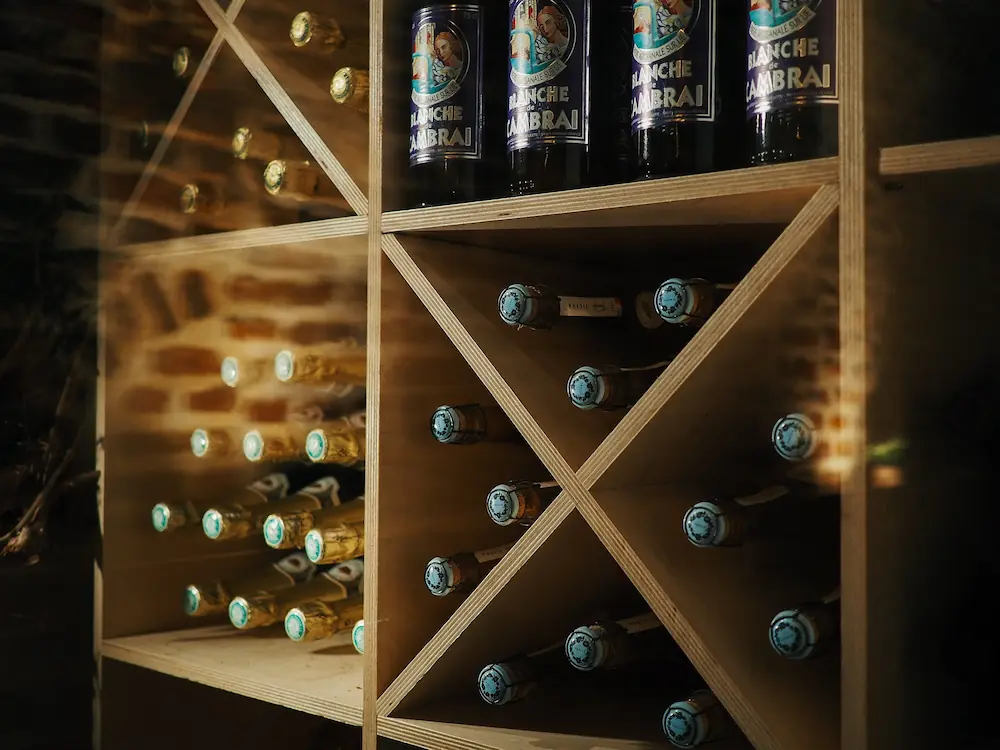
3. Overloading:
Overloading your wine cooler with too many bottles than its capacity allows can hinder proper airflow between them. This accumulation restricts cold air circulation and promotes ice formation on internal surfaces.
Solution: Avoid overfilling your wine cooler beyond its intended capacity by adhering to manufacturer guidelines or recommendations specified in its user manual.
Understanding the Proper Loading Capacities:
To prevent your wine cooler from freezing up, understanding and adhering to the correct loading capacity is crucial. The capacity is usually indicated in the user manual provided by the manufacturer and it varies based on the cooler’s size and design.
Overcrowding the cooler not only restricts airflow but can also put added strain on the cooling system, leading to inefficiencies and potentially causing freezing.
Here are some guidelines to remember when loading your wine cooler:
Guideline 1: Always refer to the user manual for specific loading instructions and maximum capacity.
Guideline 2: Leave enough space between the bottles to allow free movement of cold air. This prevents cold spots and condensation build-up which can lead to freezing.
Guideline 3: Avoid stacking bottles unless your cooler is designed for it. Stacked bottles can block air vents, disrupting airflow and causing freeze-ups.
By considering these guidelines during loading, you can ensure the optimal functioning of your wine cooler and the perfect temperature for your wines.
4. Faulty Thermostat or Temperature Sensor:
In some cases, a malfunctioning thermostat or faulty temperature sensor may inaccurately regulate temperatures inside your wine cooler, causing it to excessively cool down and freeze up.
Solution: Contact customer support for assistance if you suspect a faulty thermostat or temperature sensor issue in your unit. They can guide you through troubleshooting steps or help arrange a repair or replacement if required.
Troubleshooting Steps: Recalibrating or Replacing the Thermostat
If you’ve exhausted the above solutions and your wine cooler is still freezing up, it’s possible that the thermostat may need recalibrating or replacing. Here are some steps to guide you through the process:
Recalibrating the Thermostat:
- Locate the thermostat: Normally found on the back or bottom of your wine cooler, the thermostat is a small box-like device with a temperature reading.
- Adjust the dial: Carefully rotate the thermostat dial to the desired temperature and wait for at least 24 hours to see if the cooler maintains this temperature.
- Monitor and adjust: If the cooler’s temperature remains too low, adjust the thermostat slightly upwards and monitor the temperatures for another 24 hours.
Remember that constant monitoring and adjustment may be needed until your wine cooler stabilizes at the desired temperature.
Replacing the Thermostat:
If recalibration does not resolve the issue, you may need to replace the thermostat. This can often be a complex task and you might want to consider hiring a professional technician. However, if you are comfortable with DIY tasks, follow these steps with caution:
- Unplug the wine cooler: Always ensure the wine cooler is unplugged before starting any repair.
- Locate and remove the old thermostat: This is usually located on the back or bottom of the cooler. Unscrew and carefully disconnect the wires attached to it.
- Install the new thermostat: Connect the wires to the new thermostat following the user manual or guide that comes with the new device.
- Test the new thermostat: Turn on the wine cooler and set the thermostat to the ideal temperature for your wines. Monitor the temperature over the next 24 hours to ensure it’s working correctly.
If your wine cooler continues to freeze up after recalibrating or replacing the thermostat, it’s recommended to consult with a professional or the manufacturer’s customer service for further assistance.
5. Environmental Factors Contributing to Freezing in Wine Coolers
Environmental conditions can also contribute significantly to your wine cooler freezing up. Extreme ambient temperatures, whether too hot or too cold, can affect the performance and efficiency of your cooler.
A. Extreme Ambient Temperatures
The ambient temperature, or the temperature of the room where you place your wine cooler, can directly influence the cooler’s internal temperature, potentially leading to freezing.
1. The Effect of Extreme Temperatures on Wine Cooler Performance:
If the surrounding temperature is excessively high, your wine cooler must work harder to maintain the set internal temperature. This extra strain can lead to inefficiencies and, in some cases, cause the unit to freeze up.
On the other extreme, if the ambient temperature is too cold, the wine cooler may struggle to regulate its internal temperature and unintentionally cool down too much, leading to freezing.
2. Avoiding Extreme Environments and Providing Insulation:
Tip 1: To avoid such issues, ensure that your wine cooler is located in a room with a stable and moderate temperature.
Tip 2: Avoid placing the cooler in areas prone to extreme temperature fluctuations, such as garages, attics, or near windows exposed to direct sunlight.
Tip 3: If your wine cooler must be placed in an area with less-than-ideal temperatures, consider insulating the cooler using special thermal wraps or setting up an environmental control system for that area.
By being aware of the potential impact of environmental temperatures and taking preventive measures, you can help ensure that your wine cooler performs optimally and your wines remain in perfect condition.
6. Insufficient Insulation Within the Wine Cooler
Poorly insulated wine coolers can struggle to maintain consistent internal temperatures, leading to potential freeze-ups. Insulation plays a key role in protecting the cooler’s interior from external temperature fluctuations and ensuring it runs with maximum efficiency.
A. The Impact of Insufficient Insulation on Wine Cooler Performance
Inadequate insulation can mean the cooler unit loses or gains heat more rapidly, struggling to maintain the desired temperature for your wines. In extreme cases, this can even lead to freezing inside the cooler. Essentially, poor insulation makes the cooler work harder to maintain temperatures, reducing its efficiency and lifespan.
B. Enhancing Insulation in Your Wine Cooler
If you suspect your wine cooler is under-insulated, there are several effective solutions to consider:
Solution 1: Add additional insulation materials. Several commercially available products can be used to enhance the insulation of your wine cooler. These include foam insulation panels and insulation wraps, which can be added to the interior or exterior of the unit.
Solution 2: Use thermal curtains or blinds. These can be beneficial if your wine cooler is located near a window or in a room that experiences large temperature fluctuations.
Remember, it’s crucial to ensure any additional insulation does not block vents or interfere with the cooler’s operation. Always refer to the user manual or consult with a professional if you’re unsure.
By understanding the importance of proper insulation and taking measures to improve it, you can enhance the performance of your wine cooler, prevent freezing, and ensure the longevity and quality of your wines.
7. Additional Tips for Preventing Freezing Issues in Wine Coolers
Even with the best practices, maintaining the ideal temperature in a wine cooler can sometimes be challenging. Here are some additional tips to prevent your wine cooler from freezing:
A. Regular Maintenance and Cleaning
Over time, dust and dirt can accumulate on the condenser coils of your wine cooler, affecting its efficiency and leading to freezing issues. Regular cleaning and maintenance can help prevent this.
Tip 1: Schedule regular clean-ups for your wine cooler. Use a vacuum or a brush to carefully clean the condenser coils every few months.
Tip 2: Always ensure the interior and exterior of the wine cooler is clean. Spills and stains can affect the wine cooler’s temperature regulation. Use a mild detergent and a soft cloth for cleaning.
B. Proper Ventilation
Proper ventilation is essential for a wine cooler to function efficiently. Without it, the cooler may overheat, leading to freezing issues.
Tip 3: Make sure there is enough space around your wine cooler. It is recommended to have at least 5 inches of space on all sides for proper air circulation.
Tip 4: Never cover or obstruct the vents of your wine cooler. This can lead to overheating and subsequent freezing.
C. Appropriate Loading
How you load your wine cooler can also impact its temperature regulation.
Tip 5: Do not overcrowd your wine cooler. Overloading it can restrict air circulation, causing the cooler to work harder and leading to freezing.
Tip 6: Load your wine bottles properly. Always ensure that the bottles are not blocking the internal fan or vents.
By diligently following these additional tips, you can significantly minimize the risk of freezing issues in your wine cooler, ensuring your wines stay at their optimal temperature and quality.
Understanding the Technology Behind a Wine Cooler
A wine cooler, also known as a wine fridge, serves a dedicated purpose: to store wines at their optimal temperature, ensuring their quality remains pristine as they age.
Unlike a standard refrigerator, which operates at colder temperatures suited for food preservation, a wine cooler offers a more specific temperature range, typically between 45 to 65 degrees Fahrenheit, which is ideally suited for wine storage.
The technology behind a wine cooler is both fascinating and essential for wine preservation. Primarily, wine coolers come in two types based on their cooling mechanism: compressor-based coolers and thermoelectric coolers.
Compressor-based Wine Coolers
Compressor-based wine coolers operate similarly to conventional refrigerators, using a refrigerant and a compressor to circulate cold air throughout the cooler.
This technology enables the cooler to reach lower temperatures, making it ideal for storing a wide variety of wines.
Moreover, compressor-based wine coolers are generally more powerful and can better handle larger capacities, making them suitable for avid wine collectors.
Thermoelectric Wine Coolers
On the other hand, thermoelectric wine coolers use a different technology known as the Peltier effect.
This process involves passing an electric current across two different types of metal, creating a heat differential and thus cooling the interior of the wine cooler.
Thermoelectric wine coolers have the advantage of being quieter and more energy-efficient compared to compressor-based coolers, but they might struggle in hotter environments as their cooling capacity is directly influenced by ambient temperature.
By understanding how a wine cooler works, you can make an informed decision when purchasing a unit that best suits your wine storage needs. Regardless of the type of wine cooler you choose, maintaining optimal conditions within the cooler is crucial to prevent issues such as freeze-ups, and to ensure your wine collection ages elegantly.
Conclusion:
A wine cooler freezing up can be an inconvenience and potentially damage your precious wine collection. By ensuring the correct temperature settings, maintaining unobstructed air vents, avoiding overloading, and addressing any potential malfunctions promptly, you can prevent freeze-ups and enjoy perfectly chilled wines for years to come.
- DIY Secrets: Finding and Using the Bosch Ice Maker Reset Button
- Chest Freezer vs. Upright Freezer: Which Should You Buy?
- Say Goodbye to Stubborn Stains on Stainless Steel Pots
- Transform Your Morning Brew: Expert Tips for Better Coffee
- Effortlessly Remove Mold From Tile Grout with These Easy Steps

I’m J.S., I created and am the content manager at DIYHouseSkills.com. I do the research and write the articles that appear on this website. I’ve learned many household skills during my life and think it’s important to at least know the basics so that you can save yourself time and money… READ FULL BIO >
